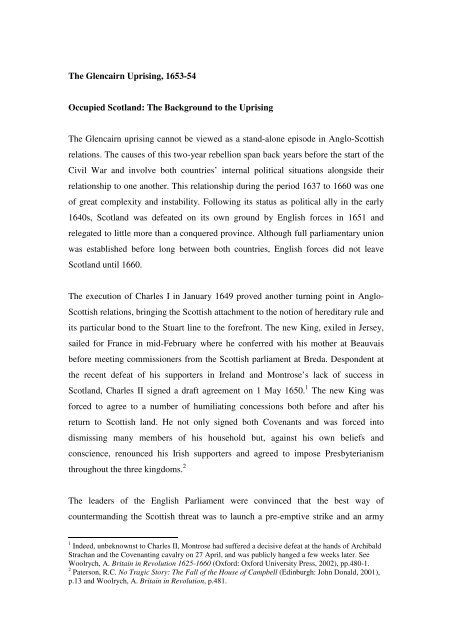The Glencairn Uprising, 1653-54 Helen Baker Department of ...
The Glencairn Uprising, 1653-54 Helen Baker Department of ...
The Glencairn Uprising, 1653-54 Helen Baker Department of ...
Create successful ePaper yourself
Turn your PDF publications into a flip-book with our unique Google optimized e-Paper software.
<strong>The</strong> <strong>Glencairn</strong> <strong>Uprising</strong>, <strong>1653</strong>-<strong>54</strong><br />
Occupied Scotland: <strong>The</strong> Background to the <strong>Uprising</strong><br />
<strong>The</strong> <strong>Glencairn</strong> uprising cannot be viewed as a stand-alone episode in Anglo-Scottish<br />
relations. <strong>The</strong> causes <strong>of</strong> this two-year rebellion span back years before the start <strong>of</strong> the<br />
Civil War and involve both countries’ internal political situations alongside their<br />
relationship to one another. This relationship during the period 1637 to 1660 was one<br />
<strong>of</strong> great complexity and instability. Following its status as political ally in the early<br />
1640s, Scotland was defeated on its own ground by English forces in 1651 and<br />
relegated to little more than a conquered province. Although full parliamentary union<br />
was established before long between both countries, English forces did not leave<br />
Scotland until 1660.<br />
<strong>The</strong> execution <strong>of</strong> Charles I in January 1649 proved another turning point in Anglo-<br />
Scottish relations, bringing the Scottish attachment to the notion <strong>of</strong> hereditary rule and<br />
its particular bond to the Stuart line to the forefront. <strong>The</strong> new King, exiled in Jersey,<br />
sailed for France in mid-February where he conferred with his mother at Beauvais<br />
before meeting commissioners from the Scottish parliament at Breda. Despondent at<br />
the recent defeat <strong>of</strong> his supporters in Ireland and Montrose’s lack <strong>of</strong> success in<br />
Scotland, Charles II signed a draft agreement on 1 May 1650. 1 <strong>The</strong> new King was<br />
forced to agree to a number <strong>of</strong> humiliating concessions both before and after his<br />
return to Scottish land. He not only signed both Covenants and was forced into<br />
dismissing many members <strong>of</strong> his household but, against his own beliefs and<br />
conscience, renounced his Irish supporters and agreed to impose Presbyterianism<br />
throughout the three kingdoms. 2<br />
<strong>The</strong> leaders <strong>of</strong> the English Parliament were convinced that the best way <strong>of</strong><br />
countermanding the Scottish threat was to launch a pre-emptive strike and an army<br />
1 Indeed, unbeknownst to Charles II, Montrose had suffered a decisive defeat at the hands <strong>of</strong> Archibald<br />
Strachan and the Covenanting cavalry on 27 April, and was publicly hanged a few weeks later. See<br />
Woolrych, A. Britain in Revolution 1625-1660 (Oxford: Oxford University Press, 2002), pp.480-1.<br />
2 Paterson, R.C. No Tragic Story: <strong>The</strong> Fall <strong>of</strong> the House <strong>of</strong> Campbell (Edinburgh: John Donald, 2001),<br />
p.13 and Woolrych, A. Britain in Revolution, p.481.
















